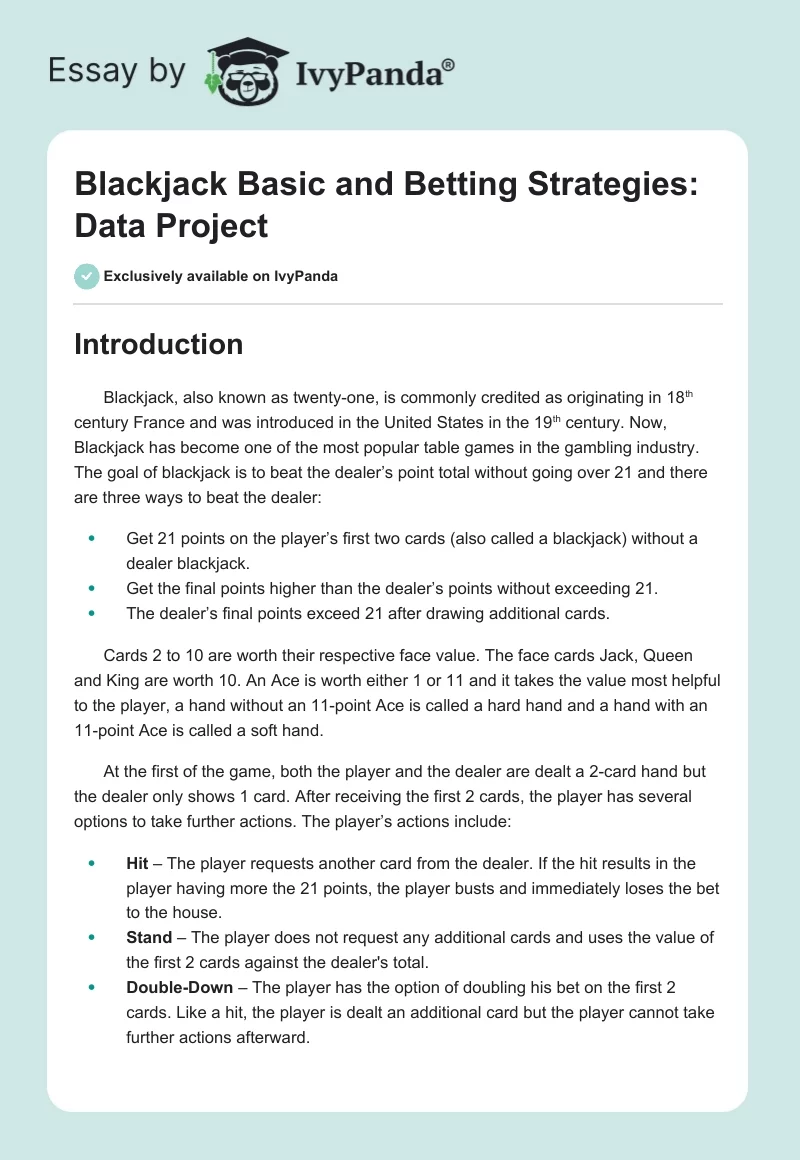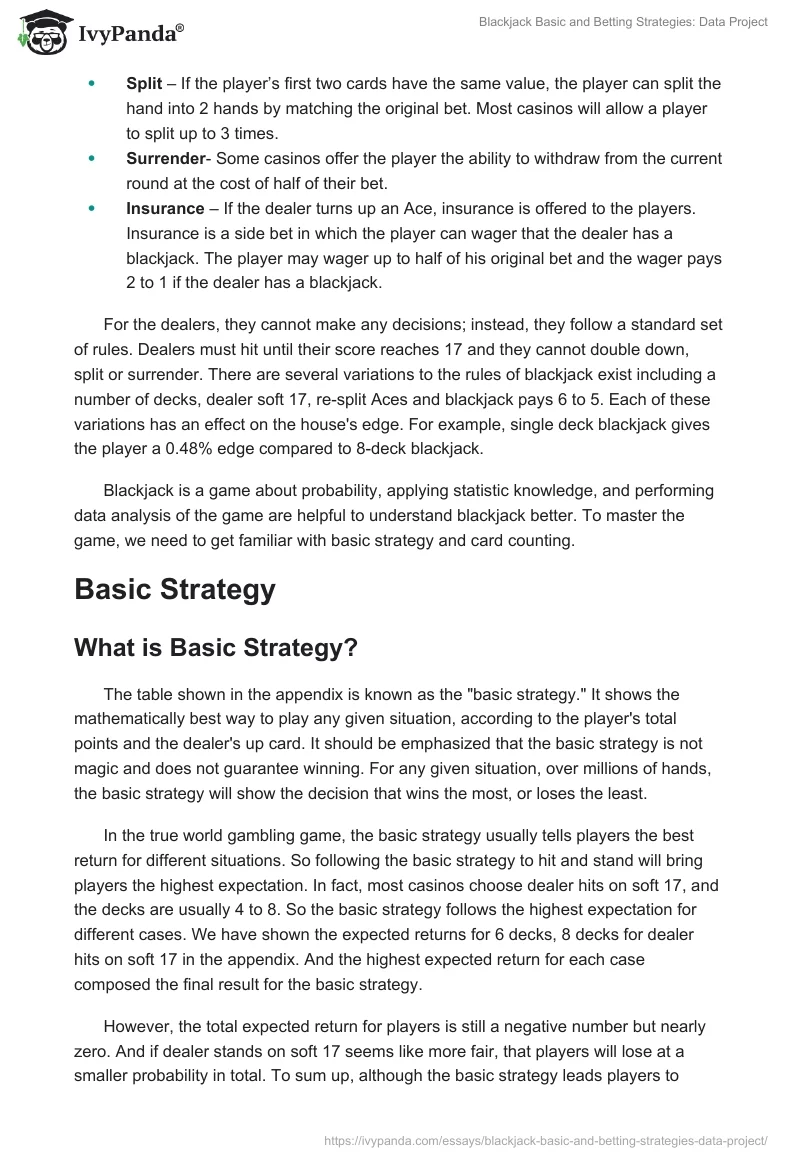Introduction
Blackjack, also known as twenty-one, is commonly credited as originating in 18th century France and was introduced in the United States in the 19th century. Now, Blackjack has become one of the most popular table games in the gambling industry. The goal of blackjack is to beat the dealer’s point total without going over 21 and there are three ways to beat the dealer:
- Get 21 points on the player’s first two cards (also called a blackjack) without a dealer blackjack.
- Get the final points higher than the dealer’s points without exceeding 21.
- The dealer’s final points exceed 21 after drawing additional cards.
Cards 2 to 10 are worth their respective face value. The face cards Jack, Queen and King are worth 10. An Ace is worth either 1 or 11 and it takes the value most helpful to the player, a hand without an 11-point Ace is called a hard hand and a hand with an 11-point Ace is called a soft hand.
At the first of the game, both the player and the dealer are dealt a 2-card hand but the dealer only shows 1 card. After receiving the first 2 cards, the player has several options to take further actions. The player’s actions include:
- Hit – The player requests another card from the dealer. If the hit results in the player having more the 21 points, the player busts and immediately loses the bet to the house.
- Stand – The player does not request any additional cards and uses the value of the first 2 cards against the dealer’s total.
- Double-Down – The player has the option of doubling his bet on the first 2 cards. Like a hit, the player is dealt an additional card but the player cannot take further actions afterward.
- Split – If the player’s first two cards have the same value, the player can split the hand into 2 hands by matching the original bet. Most casinos will allow a player to split up to 3 times.
- Surrender– Some casinos offer the player the ability to withdraw from the current round at the cost of half of their bet.
- Insurance – If the dealer turns up an Ace, insurance is offered to the players. Insurance is a side bet in which the player can wager that the dealer has a blackjack. The player may wager up to half of his original bet and the wager pays 2 to 1 if the dealer has a blackjack.
For the dealers, they cannot make any decisions; instead, they follow a standard set of rules. Dealers must hit until their score reaches 17 and they cannot double down, split or surrender. There are several variations to the rules of blackjack exist including a number of decks, dealer soft 17, re-split Aces and blackjack pays 6 to 5. Each of these variations has an effect on the house’s edge. For example, single deck blackjack gives the player a 0.48% edge compared to 8-deck blackjack.
Blackjack is a game about probability, applying statistic knowledge, and performing data analysis of the game are helpful to understand blackjack better. To master the game, we need to get familiar with basic strategy and card counting.
Basic Strategy
What is Basic Strategy?
The table shown in the appendix is known as the “basic strategy.” It shows the mathematically best way to play any given situation, according to the player’s total points and the dealer’s up card. It should be emphasized that the basic strategy is not magic and does not guarantee winning. For any given situation, over millions of hands, the basic strategy will show the decision that wins the most, or loses the least.
In the true world gambling game, the basic strategy usually tells players the best return for different situations. So following the basic strategy to hit and stand will bring players the highest expectation. In fact, most casinos choose dealer hits on soft 17, and the decks are usually 4 to 8. So the basic strategy follows the highest expectation for different cases. We have shown the expected returns for 6 decks, 8 decks for dealer hits on soft 17 in the appendix. And the highest expected return for each case composed the final result for the basic strategy.
However, the total expected return for players is still a negative number but nearly zero. And if dealer stands on soft 17 seems like more fair, that players will lose at a smaller probability in total. To sum up, although the basic strategy leads players to minimize the loss, the game itself is not a 50 to 50 game. Players should understand the rule of game and keeps a rational mind during the game. Such as our teammates concerned about “14 against 5 double down”, this idea is crazy, which will bring more than 60% of loss.
Betting strategy
Introduction
There are 4 major betting strategies people use to bet on Blackjack. All of them are based on counting cards. It is easy to understand high cards do favor to players, the more high cards on table means the winning chance of player is higher. Simply, we value the cards from 2-6 as -1, 7-9 as 0 and 10 – A as 1. Finally, truecount is given by the following formula: Truecount = Count / # of decks on table.
- Thorp strategy: This strategy is developed by Edward O. Thorp, American mathematics professor. He is the author of Beat of the Dealer, the book gives mathematically proven to overcome the deal’s advantage by card counting.
- Braun strategy: Braun strategy is based on Thorp strategy and his knowledge of computer programming.
- Hi-Low Strategy: When the truecount is larger than 2, bet 20 times the minimum bet, otherwise the minimum bet.
- MIT Team: When the truecount is larger than 2, bet (truecount * 2 * minimum bet), otherwise minimum betting unit.
How Betting strategies work

Based on the study done by David Parker, we find these betting strategies are following the normal distribution. We will describe these normal distributions in the following chart based on the rating of 1 through 5.
The higher the mean represents higher Expected return and the lower the Standard deviation represents the lower risk. Thus, even though HI-Low method gives the highest Expected return which is 6.09, it has the largest standard deviation (Risk). These experiments depend on a large numbers of data sets which means you need lots of money to test in a real life. Overall, we conclude that people’s betting distributions should follow their risk aversion distributions.
From the results of the above game, it is apparent that strategic statistical focusing has the potential of creating a fairly accurate prediction when the probability and the risk margins are balanced. For instance, application of different betting strategies has different results within diverse margins of risk when different statistical values are used. This means that a strategic profiling sub-game involving players in the stages of the large game would constitutes the perfect equilibrium through backward induction if the player carries out proper focusing using different statistical tools. Through backward induction of the numerous outcomes that are likely to occur within the game, the player is in a position to simultaneously eliminate branches consisting of non credible moves organized by any of the players (Zelterman 45). From the above illustration, it is apparent that there is a distinct difference between proper use of statistical tools in focusing and playing without any strategy. In the first case, there is the potential of winning at minimal risk since all the moves are preplanned as compared to the second alternative, where the risk appetite is high and probability of winning has a low margin (Marques 42). Same as data analysis, the ability to balance different relevant sets has the potential of creating a perfect result, even when the analysis is based on very minimal probability limits.
After imposition of the data analysis strategies in the planning for the game, it is possible determine the moves that would result to at least a win, even if the margin is low. Therefore, there is always a state of normal distribution when the probability is integrated at different levels of risk in data analysis (Giudici 31). After the results of the normal distribution, any rational opponent among the players will be automatically precluded from repeating the previous move to ensure that no credible moves are eliminated. This means that statistical analysis is also accurate when perfect information is balanced to focusing, risk level, and data sets are accurate (Cohen 34). However, I could not address the subsets of data that could sway the result in either way with a counteractive strategy is applied within the initial data sets.
This project has improved my understanding of data analysis and statistics has improved. Specifically, I came to realize that any data analysis must be accompanied by identification of variables, extraction of themes, enumeration of the questions and calculation of the answers, highlighting similarities and differences, and creation of the diagrams on the basis of the answers derived (Sato 18). Data analysis and statistics help to clarify if the groups chosen for analysis can be statistically different from each other or not. This analysis helps to compare the achievements of different groups. The level of measurement identifies the relation between the values of different parameters and how the risk level is attributed to each set (Giudici and Figini 25). With the help of the answers and the observations made on the groups, it is possible to clarify if series of data sets can be aligned to a predefined parameter at each level of test or limit to facilitate accurate interpretation of the results. The result of any data analysis is dependent on the type of data sets being used and the parameters that define the dependent and independent variables.
Works Cited
Cohen, Patricia. Applied Data Analytic Techniques for Turning Points Research, New York: Routledge, 2008. Print.
Giudici, Paolo, and Silvia Figini. Applied Data Mining for Business and Industry, New York: John Wiley & Sons, 2009. Print.
Giudici, Paolo. Applied Data Mining: Statistical Methods for Business and Industry, New York: John Wiley & Sons, 2005. Print.
Marques, Joaquim. Applied Statistics Using SPSS, STATISTICA and MATLAB, Alabama: Springer Science & Business Media, 2013. Print.
Sato, Aki-Hiro. Applied Data-Centric Social Sciences: Concepts, Data, Computation, and Theory, Alabama: Springer, 2014. Print
Zelterman, Daniel. Applied Multivariate Statistics with R, New York: Springer, 2015. Print.


